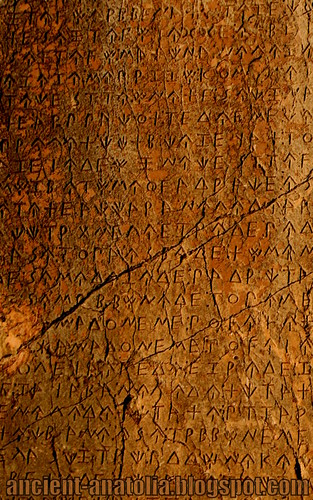 Lycian Script on Xanthos Stele.
Lycian Script on Xanthos Stele.Lycian language Trm̃mili refers to the inscriptional language of ancient Lycia, populated by Lycians, as well as its presumed spoken counterpart.
Lycia covered the region lying between the modern cities of Antalya and Fethiye in southern Turkey, and especially the mountainous headland between Fethiye Bay and the Gulf of Antalya. The Lukka, as they were referred to in ancient Egyptian sources which mentions them among the Sea Peoples, probably also inhabited the region called Lycaonia, located along the next headland to the east, also mountainous, between the modern cities of Antalya and Mersin.
Their language, Lycian, was an Indo-European language, one in the Luwian subgroup of Anatolian languages. The Luwian subgroup comprised also cuneiform and hieroglyphic Luwian, Carian, Sidetic and Pisidic. All but Luwian were spoken only in the Iron Age, after roughly 1000 BC; thus neither the Lukka of the time of the Sea Peoples nor the Lycians cited among the allies of the Trojans during the Trojan War could have spoken any Lycian. Luwian language, on the other hand, extended back into the Late Bronze Age and preceded the fall of the Hittite Empire. This language vanished at about the time of the Neo-Hittite states in southern Anatolia (and Syria); thus, the Iron Age members of the subgroup are localized daughter languages of Luwian. Whether the Lukka people always resided in southern Anatolia or whether they always spoke Luwian are different topics. Lycian became extinct around the beginning of the first century BC, having been replaced by the Ancient Greek language.
PHOTO: Xanthos Stele by ancient-anatolia.blogspot.com